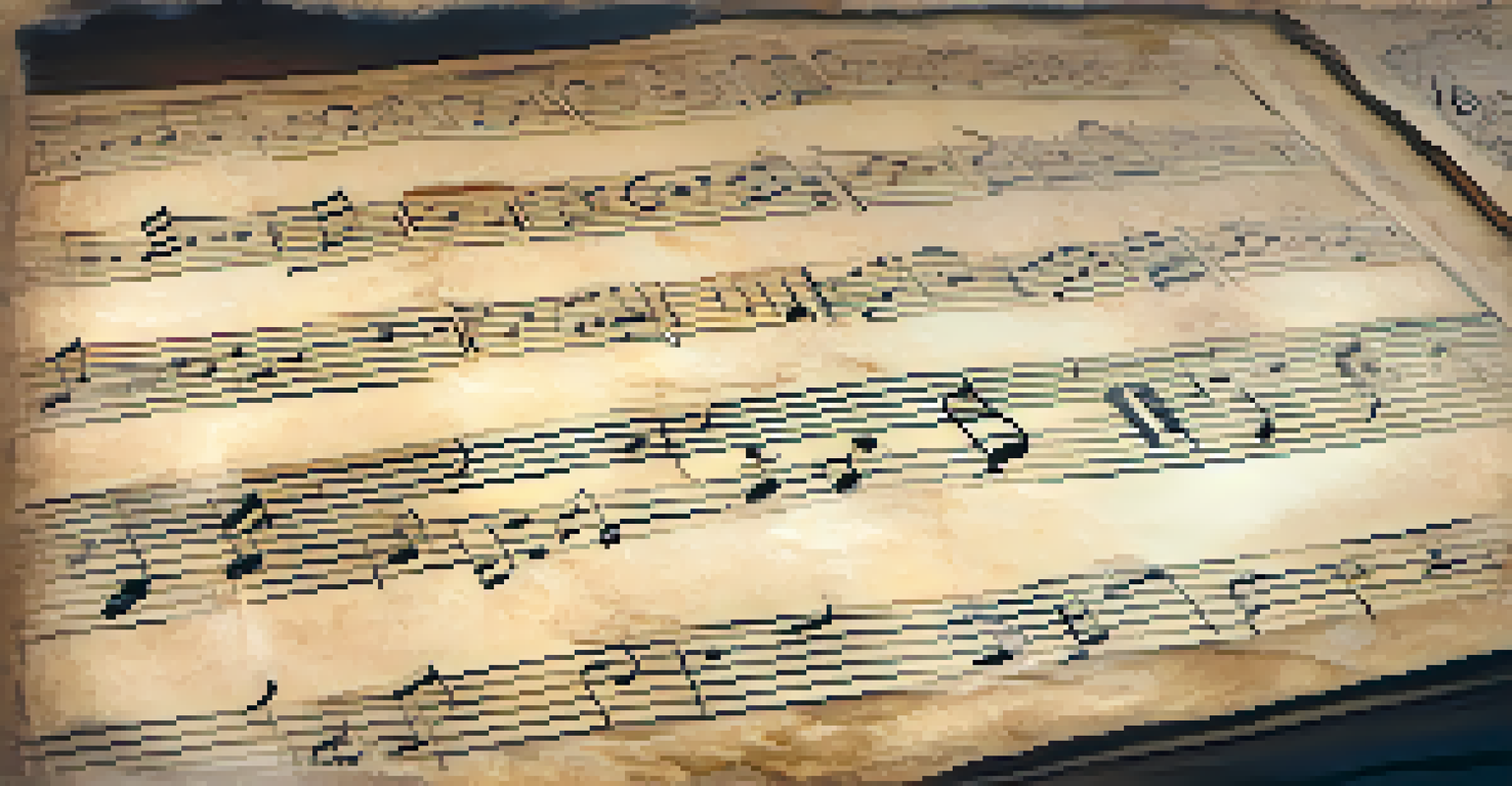Byzantine Music: Sacred Sounds and Cultural Transmission

The Origins of Byzantine Music and Its Cultural Context
Byzantine music has its roots in the early Christian period, emerging from the rich tapestry of Roman and Greek musical traditions. This unique style developed within the Eastern Orthodox Church, reflecting both religious and cultural influences of the Byzantine Empire. The music was not just an art form; it served as a means of worship, helping to elevate the spiritual experience of the congregation.
Music is the shorthand of emotion.
As the Byzantine Empire expanded, so did its musical influence, absorbing elements from various cultures it encountered. This blending of styles contributed to the evolution of Byzantine music, creating a distinct sound characterized by its monophonic texture—meaning it consists of a single melodic line without harmonic accompaniment. This simplicity allowed for a focus on the lyrics and the spiritual messages they conveyed.
The music was primarily vocal, often featuring choirs that would perform in churches during liturgical services. The use of Greek language and religious texts played a crucial role in preserving the heritage of Byzantine music, making it a vital part of the cultural transmission across generations.
The Structure and Notation of Byzantine Chant
Byzantine chant is structured around a system of modes, which are akin to scales in Western music. These modes guide the melodic development and emotional expression within the pieces, allowing for a rich variety of musical expressions. The most common modes include the Dorian, Phrygian, and Mixolydian, each bringing a unique flavor to the music.

The notation system used in Byzantine music is fascinating and distinct from Western notation. It employs a series of symbols known as neumes, which indicate pitch, duration, and modulation. This system was primarily a mnemonic device for singers, making it easier to memorize the complex melodies rather than providing exact pitches as modern sheet music does.
Roots of Byzantine Music
Byzantine music originated from early Christian traditions, blending Roman and Greek influences within the Eastern Orthodox Church.
Understanding this notation is crucial for appreciating the depth of Byzantine music. It reflects the artistry and intricacies of the compositions, as well as the reverence in which the music was held, ensuring that it was performed with the utmost respect and fidelity to its spiritual roots.
The Role of Byzantine Music in Religious Practices
In Byzantine worship, music played a foundational role, transforming the liturgical experience into a profound spiritual journey. The chants were often sung during the Divine Liturgy, the equivalent of a church service, helping to create an atmosphere of reverence and devotion. This musical element not only engaged the congregation but also facilitated a deep connection to the divine.
Without music, life would be a mistake.
The use of music was not limited to Sundays; it permeated various religious celebrations and festivals, marking significant events in the church calendar. Each occasion had its own set of hymns, specifically composed to reflect the themes of the day, be it Christmas, Easter, or other saints' feast days. This continuity of music through the church year helped to reinforce the teachings and traditions of the Orthodox faith.
Moreover, the melodies themselves often conveyed theological concepts, making the music an essential tool for educating the faithful. By embedding teachings within the music, the church ensured that even illiterate congregants could grasp the core tenets of their faith through the power of song.
The Influence of Byzantine Music on Neighboring Cultures
As the Byzantine Empire expanded, its music began to influence neighboring regions, particularly in Eastern Europe and the Middle East. This cross-cultural interaction led to the adoption and adaptation of Byzantine musical styles, which enriched the musical heritage of these areas. Countries such as Greece, Russia, and Serbia embraced Byzantine music, incorporating it into their own liturgical practices.
The spread of Orthodox Christianity further facilitated the dissemination of Byzantine music, as new converts adopted the liturgical traditions of the Byzantine Church. This cultural exchange resulted in a fusion of musical elements that can still be heard in contemporary Eastern Orthodox liturgies today. For instance, Russian Orthodox music exhibits significant Byzantine influences, evident in its melodic structures and chant styles.
Cultural Influence and Adaptation
The expansion of the Byzantine Empire allowed its music to influence neighboring cultures, leading to the adoption and adaptation of its musical styles in Eastern Europe and the Middle East.
Additionally, the migration of Byzantine musicians and scholars helped to solidify the impact of Byzantine music in various cultural contexts. This migration allowed for the sharing of knowledge and techniques, ensuring that the legacy of Byzantine music would endure and evolve in new environments.
The Preservation and Revival of Byzantine Music
Despite the challenges faced over the centuries, efforts to preserve Byzantine music have flourished in recent decades. Scholars and musicians have dedicated themselves to studying ancient manuscripts and reconstructing the original sounds of Byzantine chant. This revival has sparked renewed interest in the music, both within the Orthodox community and among music enthusiasts worldwide.
Many educational institutions now offer courses in Byzantine music, ensuring that future generations can learn and appreciate this rich cultural heritage. Workshops and festivals dedicated to Byzantine music have also emerged, bringing together performers and scholars to share their passion and knowledge. These gatherings foster a sense of community and help to keep the tradition alive.
In a world increasingly driven by modernity, the resurgence of interest in Byzantine music serves as a reminder of the importance of cultural heritage. By preserving these sacred sounds, we not only honor the past but also enrich our present and future musical landscapes.
The Emotional and Spiritual Impact of Byzantine Music
Byzantine music is renowned for its profound emotional resonance, often evoking a deep sense of spirituality in listeners. The use of modal scales and intricate melodies creates an atmosphere that encourages introspection and contemplation. Many people find solace in these sacred sounds, using them as a tool for meditation and spiritual connection.
The chants, steeped in theological meaning, facilitate a personal encounter with the divine. Listeners often describe experiencing a sense of peace and transcendence while immersed in the music, highlighting its power to touch the soul. This emotional depth is one reason why Byzantine music continues to resonate with audiences today.
Modern Revival and Interpretation
In recent years, there has been a resurgence of interest in Byzantine music, with contemporary musicians reinterpreting traditional elements to make it relevant for new audiences.
Moreover, the communal aspect of Byzantine music, with its rich choral traditions, fosters a sense of unity among worshippers. Singing together during services nurtures a shared spiritual experience, reinforcing bonds within the community and creating a lasting impact on individual lives.
Modern Interpretations and Adaptations of Byzantine Music
In recent years, contemporary musicians have begun reinterpreting Byzantine music, blending traditional elements with modern styles. This creative fusion has led to innovative compositions that attract a diverse audience, demonstrating the music's adaptability and relevance in today’s world. Artists experiment with different genres, incorporating Byzantine motifs into pop, jazz, and even electronic music.
These modern interpretations help to bridge the gap between ancient traditions and contemporary culture, making Byzantine music accessible to new generations. By infusing traditional melodies with modern instrumentation and arrangements, musicians breathe new life into these sacred sounds. This approach not only preserves the essence of Byzantine music but also invites fresh perspectives and appreciation.

Through these adaptations, Byzantine music continues to evolve, proving that while its roots are firmly planted in the past, its branches reach far into the future. This dynamic interplay between tradition and innovation keeps the music alive, ensuring that it remains a relevant part of our cultural landscape.